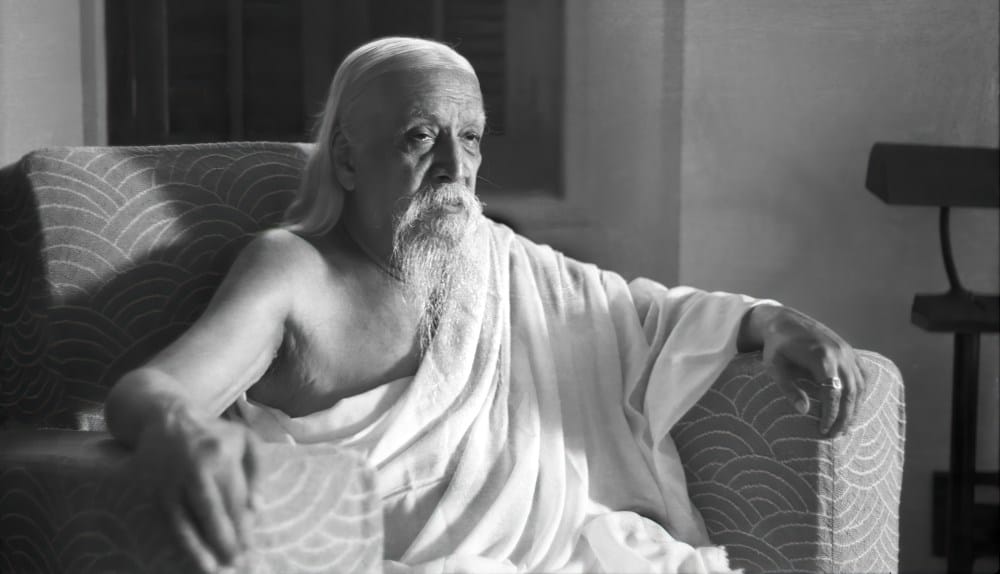
Sri Aurobindo was born in Calcutta on August 15, 1872. In 1879, at the age of seven, he was taken with his two elder brothers to England for education and lived there for fourteen years. Brought up at first in an English family at Manchester, he joined St. Paul’s School in London in 1884 and in 1890 went from it with a senior classical scholarship to King’s College, Cambridge, where he studied for two years.
Sri Aurobindo passed thirteen years, from 1893 to 1906, in the Baroda Service, first in the Revenue Department and in secretariat work for the Maharaja, afterwards as Professor of English and, finally, Vice-Principal in the Baroda College. [. . .] A great part of the last years of this period was spent on leave in silent political activity, for he was debarred from public action by his position at Baroda. The outbreak of the agitation against the partition of Bengal in 1905 gave him the opportunity to give up the Baroda Service and join openly in the political movement. He left Baroda in 1906 and went to Calcutta as Principal of the newly-founded Bengal National College.
The political action of Sri Aurobindo covered eight years, from 1902 to 1910. During the first half of this period he worked behind the scenes, preparing with other co-workers the beginnings of the Swadeshi (Indian Sinn Fein) movement, till the agitation in Bengal furnished an opening for the public initiation of a more forward and direct political action than the moderate reformism which had till then been the creed of the Indian National Congress. [. . .] Sri Aurobindo hoped to capture the Congress and make it the directing centre of an organised national action, an informal State within the State, which would carry on the struggle for freedom till it was won.
Sri Aurobindo was prosecuted for sedition in 1907 and acquitted. Up till now an organiser and writer, he was obliged by this event and by the imprisonment or disappearance of other leaders to come forward as the acknowledged head of the party in Bengal and to appear on the platform for the first time as a speaker. He presided over the Nationalist Conference at Surat in 1907 where in the forceful clash of two equal parties the Congress was broken to pieces. In May, 1908, he was arrested in the Alipur Conspiracy Case as implicated in the doings of the revolutionary group led by his brother Barindra; but no evidence of any value could be established against him and in this case too he was acquitted. After a detention of one year as undertrial prisoner in the Alipur Jail, he came out in May, 1909, to find the party organisation broken, its leaders scattered by imprisonment, deportation or self-imposed exile and the party itself still existent but dumb and dispirited and incapable of any strenuous action. For almost a year he strove single-handed as the sole remaining leader of the Nationalists in India to revive the movement. He published at this time to aid his effort a weekly English paper, the Karmayogin, and a Bengali weekly, the Dharma. But at last he was compelled to recognise that the nation was not yet sufficiently trained to carry out his policy and programme. [. . .] Moreover, since his twelve months’ detention in the Alipur Jail, which had been spent entirely in the practice of Yoga, his inner spiritual life was pressing upon him for an exclusive concentration. He resolved therefore to withdraw from the political field, at least for a time.
In February, 1910, he withdrew to a secret retirement at Chandernagore and in the beginning of April sailed for Pondicherry in French India. [. . .]
During all his stay at Pondicherry from 1910 [until his passing in 1950 he] remained more and more exclusively devoted to his spiritual work and his sadhana. In 1914 after four years of silent Yoga he began the publication of a philosophical monthly, the Arya. Most of his more important works [. . .] appeared serially in the Arya. These works embodied much of the inner knowledge that had come to him in his practice of Yoga. [. . .] The Arya ceased publication in 1921 after six years and a half of uninterrupted appearance.
Sri Aurobindo lived at first in retirement at Pondicherry with four or five disciples. Afterwards more and yet more began to come to him to follow his spiritual path and the number became so large that a community of sadhaks had to be formed for the maintenance and collective guidance of those who had left everything behind for the sake of a higher life. This was the foundation of the Sri Aurobindo Ashram which has less been created than grown around him as its centre.
Sri Aurobindo began his practice of Yoga in 1905. At first gathering into it the essential elements of spiritual experience that are gained by the paths of divine communion and spiritual realisation followed till now in India, he passed on in search of a more complete experience uniting and harmonising the two ends of existence, Spirit and Matter. Most ways of Yoga are paths to the Beyond leading to the Spirit and, in the end, away from life; Sri Aurobindo’s rises to the Spirit to redescend with its gains bringing the light and power and bliss of the Spirit into life to transform it. [. . .] It is possible by opening to a greater divine consciousness to rise to this power of light and bliss, discover one’s true self, remain in constant union with the Divine and bring down the supramental Force for the transformation of mind and life and body. To realise this possibility has been the dynamic aim of Sri Aurobindo’s Yoga.
Written by Sri Aurobindo. Edited material marked by brackets. From the booklet, Sri Aurobindo and his Ashram, pp. 2-6, published in 1983 by the Sri Aurobindo Ashram, Pondicherry.
